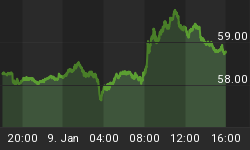As the chart below shows, the money supply in the United States has increased dramatically since 1994.

Increasing or "inflating" the money supply helps create what we often refer to as inflation or rising prices. We experience "good inflation" when the price of our stocks or home increases. We experience "bad inflation" when oil hits $80 per barrel. Rising asset values (homes, stocks, etc.) are a form of inflation, but no one gets upset when they feel weathier after looking at their 401(k) statement or home equity report. Asset inflation feels good, but is it just an illusion of increased wealth driven largely by an ever increasing money supply?
When President Nixon closed the gold window in 1971, the U.S. dollar went off the gold standard. The dollar in your wallet cannot be exchanged for gold. The dollar is simply backed by the "full faith and credit" of the U.S. government. Today, no major currency is on the gold standard. As a result, gold acts as the world's only true currency. We can create an endless supply of new paper money using the fractional reserve banking system in the United States. We cannot endlessly increase the supply of gold (especially in the short run). As a result, gold represents a better place to store wealth than any paper or fiat currency.
In the financial press, the appeal of gold is often portrayed as a way to protect yourself from "end-of-the-world" events. The press tells us that people buy gold because they are fearful. There is no question that there is some truth to that concept. However, I would argue that the real appeal of gold is that it enables you to protect yourself from constant money creation which erodes the purchasing power of paper currencies. As the chart below shows, the U.S. dollar, as measured vs. a basket of foriegn currencies via the U.S. Dollar Index (shown in red below), has lost roughly 30% of its purchasing power since July of 2001. The endless creation of credit and the dollar's decline has not gone unnoticed by many investors. These investors have flocked to gold (shown in blue).

Has Anyone Really Made Any Money In Stocks, Bonds, & Real Estate?
Let's start with bond investors. The Vanguard Intermediate Bond Index (red line below) has appreciated roughly 10% since July of 2001. If we include dividends (not shown in chart), the total nominal return is a more repsectable 34%. Unfortunately, the purchasing power of the U.S. dollar (blue line below) has dropped roughly 30% in the same period. That means the real return vs. the dollar is only 4%. A 4% real return for parking your money for over five years (2001-2006).

Now you can understand why I don't like bonds as a long term investment. I do, however, like them for the next 6 to 24 months as the economy continues to slow and the odds of a FED rate cut increase.
The news is no better for stock investors. Using the Vanguard 500 Index as a proxy, the total return, including dividends (not shown in chart), was roughly 26% since July of 2001. That means vs. the 30% loss of purchasing power in the dollar, stock investors (in real terms) have lost money in the past five years. In chart below, blue line is the S&P 500, the green line is the Dow, and the red line is the U.S. Dollar Index.

In a similar vein, if we look at the ratio of the S&P 500 to gold (below), it shows that stocks are down vs. the world's only true currency since July of 2005 (during a "great bull run" for stocks).

Using the Dow Jones Real Estate Index as a proxy, the picture is for real estate is nothing to write home about in gold terms (see chart below).

To better understand our point of reference, the pie chart below shows the currency weightings for the U.S. Dollar Index:

What Does It Mean Now? While I am very bullish on gold for the next 5 to 10 years, you should also be aware that secular bull markets can see substancial corrections. Gold may also go sideways for a few years (see 1975-1977) before resuming an uptrend. Many of the concepts presented here, such as scarcity vs. endless paper money creation, can also be applied in general to many commodities, not just gold. I am confident that diversified investors who own both oil and gold will be very happy 5 to 10 years from now regardless of what happens in the next 2 years. If you have even just small exposure to gold & oil as we enter a period of economic contration, you can always add to your positions should they become profitable. Having no exposure may cause you to miss some significant upside as the money creation continues in the coming years.
This article is Part Three of a Seven Part Series:
Interesting external links:
- How Is The Money Supply Controlled?
- Environment When Nixon Closed the Gold Window
- Swiss Drop Gold Standard















